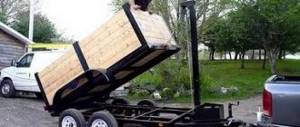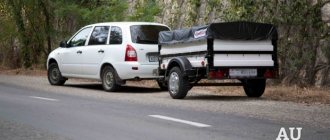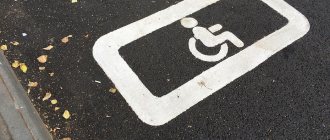About the established rules for driving with a trailer
Recently, there have been constant changes or additions to traffic rules regarding various issues.
According to the new rules, a tow hitch is also a vehicle and in cases specified by law, namely for legal entities and when transporting goods over 3.5 tons, it must be registered, and the driver when transporting goods exceeding the total weight of 3.5 tons of the road train must have the appropriate category “E” on your driver’s license.
There are more different nuances regarding the transportation of cargo in a trailer, and the order of qualification groups in the traffic rules has expanded; when passing the exam to drive a vehicle with a trailer, the driver must have a certain driver’s category in his license.
The answer to the question of how to drive with a trailer and what documents are needed when driving a vehicle is as follows:
- Driving with a trailer in a passenger car without documents is prohibited; a traffic police officer may issue a fine if a violation is detected;
- The towbar must be registered and have only standard certified towbar coupling devices. Homemade devices without certificates are prohibited;
- The trailer must have working lighting, signaling and dimensional devices that allow you to indicate the movement of the tow hitch and its maneuvers on the road, as well as rear-view mirrors with adjustable extensions that allow you to see the overview of the trailer in motion;
- According to established traffic rules, when driving with a trailer as part of a road train with a total weight of up to 3.5 tons on highways, outside populated areas, the vehicle speed should not exceed 90 km per hour. And on other highways at more than 70 km per hour or according to the established speed limits;
- A driver with license category “B” has the right to use a trailer with a weight not exceeding the weight of the tractor and the total weight of the road train should not exceed 3.5 tons;
- When using a trailer, the permissible overall dimensions of the towing device must be observed; the width is no more than 2.55 m, the height is up to 4 m and the total length of the road train, tractor with trailer should not be more than 20 meters;
- In conditions with limited visibility, it is not recommended to use a towed mechanism on the road;
- The trailer should be used only for its intended purpose, it is prohibited to transport people in the trailer, and it is also forbidden to use the trailer when the visibility of the cargo is poor, when the warning devices, registration sign are covered, or when the towed vehicle is unstable;
- The towbar must have wheel wedges in its design in case of an emergency stop on a sloped road.
How to connect a modern car with a trailer? The nuances of installing a towbar
The trailer is a favorite accessory of avid summer residents, experienced car travelers, as well as many small businessmen from the construction and trade sectors. Its cost is not that high, but the advantages are enormous. However, those who plan to install a towbar with their own hands on a modern car, and not on their grandfather’s “penny”, may encounter some difficulties...
The trailer has a lot of advantages. There is, in fact, one minus, but a huge one - difficulties with storage... In many cities today there is nowhere to park the car itself, let alone parking the “cart”... However, if you have no difficulties with storing a trailer and you are planning to buy it, they remain , in fact, minor troubles - installing a towing device on a car, popularly called a towbar. This is not too difficult, which is why many car owners have traditionally installed the tow bar themselves and installed the electrical wiring to the trailer themselves. However, a lot has changed over the years.
How it was on old cars
Not so long ago, connecting the towbar electrics did not pose any problems for owners of Zhiguli, Muscovites, Volzhankas and old foreign cars, and was carried out on their own - skills in the simplest household electrical equipment were sufficient for this.
The trailer light bulbs were simply connected parallel to the light bulbs at the rear of the car - one to one. The process was also facilitated and accelerated by combining paired lamps (brake lights and parking lights) into groups on one wire, which was par for the course on older cars. A couple of hours of fussing - and you're done!
And the cunning people, who did not want their friends to beg them for a “cart” for a trip to the country or to the south, also swapped a couple of pins in the connector block - their own combination in the order of contacts made it possible to make the trailer compatible only with their own car...
The canonical classic direct connection of the towbar to the electrical equipment of the car:
Why is everything more complicated now?
However, today the grandfather’s method of connecting “lamp to lamp” has lost its relevance. This happened for two reasons. Firstly, the electronics of a modern (even budget) car, as a rule, constantly monitors the integrity of the lamps in the lights at the rear of the car, since these days their serviceability is considered to be a very serious factor in traffic safety. The electronics compares the known rated current load from a standard lamp with reality, and “sees” a burnt-out lamp, one that is missing, or one with a sharply increased current consumption - namely, the latter case corresponds to connecting a trailer, when the power of all lamps doubles. This leads, at the very least, to the ignition of the “check”, and in the worst case – to glitches in the operation of the “stoppers” and “turn signals”.
Secondly (this aspect is of less importance, but still important), a banal doubling of the power of electrical consumers can have a bad effect on the electrical wiring of a car, which today is done extremely economically: there is not a single extra copper hair in the wires to consumers - everything is strictly calculated with a minimum in stock! And doubling the load can easily lead to dangerous heating.
For these reasons, today it is practiced to connect the electrical equipment of a trailer to a car using electronic switching units, popularly known as “smart connect”. Smart connect modules serve as intermediaries between the trailer’s electrical system and the car’s electrical system, and use the latter only as a source of commands, and not as a power unit.
What is a “smart connection” and which one to choose?
Smart connect blocks can be expensive original ones or budget-friendly universal ones. The first ones are relevant for cars in the middle and high price segments, with fairly advanced electronics. They receive commands via the CAN bus and in their work take into account a lot of different processes occurring in the car. It is not advisable to install them in a garage, and even in a small multi-brand service center, where they are used to changing oil, pads and starters without any fuss. In this case, it is not worth doing homemade work and turning to “general professionals”.
About preparing a trailer for operation and fines for violations
The driver must remember that the towbar should also be inspected and serviced before making a trip. You must be sure that it is in good working order and meets safety requirements.
The following measures should be taken before traveling with a tow hitch:
- Check the reliability of the connection between the trailer coupling mechanism and the vehicle. Duplicate the hitch with a safety connection;
- Lubricate the joints of the towbar, check for play in the connection and eliminate it if it appears;
- Inspect all light signaling devices, replace faulty lamps;
- Check the free movement of the wheels of the towbar and, if necessary, apply lubricant to the wheel bearings;
- Check the condition of shock absorbers, springs, reliability of fastening and absence of leaks;
- Finally, the tire pressure is checked; it must be no less than the established norm according to the passport.
The driver must comply with the loading standards on the towbar and the rules for placing and securing the load. Overload is not allowed. When placing a load on a single-axle trailer, it is very important to position the load strictly on the trailer axis and secure it.
A slight displacement can affect the stability and maneuverability of the towbar and the load can even break the hitch. Excessive forward movement of the load can prematurely wear out the trailer hitch and lead to deformation of the tow bar.
Shifting the load backward reduces the safety of transportation; contact and controllability drop sharply. Premature wear of car and trailer tires occurs. Avoid shifting the load and secure it using seat belts.
If the driver fails to comply with traffic rules while driving a car with a tow hitch, an administrative fine may be applied to the driver in the following cases:
- In case of incorrect transportation of cargo in the amount of 500 rubles;
- There is no open category in rights when transporting cargo in excess of established norms, up to 5,000 rubles;
- If there are no transit or other license plates on the trailer, a fine of 5,000 rubles or deprivation of a driver’s license will be imposed;
- There is no MTPL policy or there is no information about the trailer in it;
- The trailer or tractor is faulty or the docking is incorrect. In this case, you should stop driving and fix the problem;
- The trailer creates an emergency situation due to improper driver control.
Step-by-step instruction
Many passenger cars do not have a standard tow bar. How to attach a light trailer in this case? First you need to purchase a towbar. It is recommended to choose a model made of stainless steel or with a protective polymer coating. It is installed in a standard place or attached to holes made independently in the frame.
How to attach a trailer to a car so that it does not fall off while driving? It is necessary to drive as close to the car as possible without causing a collision. At this time, the trailer is located on the stand. The car is put on the parking brake and the engine is turned off. The trailer hitch is lowered onto the towbar ball, then the driver lowers the clamp. The next step is to attach the locking lock. If everything is done correctly, the trailer will not go anywhere - it is securely attached to the towbar ball.
At the last stage, the car and trailer are connected with chains. This is an additional measure of protection - if the caravan somehow becomes detached, the chains will hold it, preventing it from touching the road. The driver will only have to brake smoothly and return the vehicle coupling to its original state.
Finally, all that remains is to connect the trailer to the vehicle’s on-board network. A standard connector is used for this. The car itself is equipped with a similar connector. Experienced drivers know how to attach a trailer to a car - their actions are brought to automaticity. Beginners get used to it quickly, because there is nothing complicated about it. But before setting off, both drivers (novice and professional) must check the functionality of the lights.
The easiest way to check the lights is with two people - the driver presses the brake pedal or turns on the turn signals one at a time, and the second person monitors the performance of the lights. If you do not have an assistant, you should use a mirror or drive up backwards to any obstacle to see the reflection of light on its surface. By paying attention to this procedure, drivers will ensure their own safety on the road.
About the features of driving with a trailer
Each driver has to master the skills of driving with a towbar on his own, gradually delving into the process of control and driving. And the method of reversing with a trailer is generally unique in each case and a beginner will not be able to cope with it right away.
When driving back with a tow hitch, you should monitor the condition of the trailer in the rear mirror; when it moves to the right, turn the steering wheel to the left and otherwise in the opposite sequence. The steering wheel should be turned smoothly without sudden jerks to avoid turning the trailer sideways.
The main driving features include the following:
- When starting, movement with the tow hitch should be carried out smoothly without sudden jerks;
- Along the route, move at a steady speed, smoothly accelerating or slowing down;
- Turns and overtaking on the highway should be done with extreme caution, using the calculated margin for maneuvers. And when driving in an urban environment, provide in advance for all subsequent lane changes and braking at intersections;
- When there is heavy traffic, take into account the distance from the nearest cars and the braking distance;
- Observe the established speed limit, take into account weather conditions, gusts of wind and precipitation when driving on the highway;
- If the towbar skids, try to level it in motion by increasing the speed or steering in the opposite direction.
Getting started and basic technical nuances
Once you have a driving school under your belt and have received a driver's license, you should move on to driving practice.
One of the most important stages is loading and securing the cargo of a single-axle passenger car trailer, since it is this that determines the tension created on the clutch mechanisms. The bottom line is that the trailer will move optimally only if the load is evenly distributed over its entire area. If the weight falls on the rear axle of the trailer, the rear axle of the car will rise, which, of course, will negatively affect handling. On the other hand, when the front axle is loaded, the trailer itself can be made uncontrollable and will dangle arbitrarily. When the car’s grip on the road decreases, it becomes almost impossible to brake quickly, which will significantly complicate the driver’s life and safety on the road.
When driving with a trailer, it is very important to understand that it is in fact another vehicle. It also has suspension, a certain ability to overcome uneven road surfaces, etc., which undoubtedly affects its towing characteristics. The highest skill in driving a car with a trailer is to avoid any hole not only with the car, but also with the trailer.
The art of maneuver when driving in such a complex combination is what a driving instructor should teach a driver in a driving school, so that the MREO traffic police examiner, taking a practical exam, has no reason to doubt the driving skills of a driver candidate. A careless turn could cause the trailer to drag the vehicle into a ditch and cause injury to other road users. The most sensible action for the driver of a car with a trailer is to choose the correct speed when entering a turn and the turning radius.
Another feature of cornering is cutting corners when changing direction. It must be taken into account that the trailer cuts the corner when turning even more than the wheels of the rear axle of the car. It is necessary to adhere to the trajectory of movement with the largest turning radius and ensure that the entire hitch goes through the turn without connecting with the curb or nearby cars.
The most difficult thing when passing a practical driving test at the traffic police is the ability to park in a narrow space, remembering that the trailer does not move along a perfectly flat path. It is worth remembering the following combination of movements: car to the left - trailer to the right, car to the right - trailer to the left. This is how the hitch moves when reversing. Thus, when moving backwards, the driver must control his actions with double care.
Based on all of the above, we can conclude that any driving school is simply obliged to give the driver the following knowledge:
- when driving a car with a trailer, teach not only how to park in narrow spaces, but also how to reverse;
- teach to assess the situation, since the dynamics of driving a car with a trailer differs from driving just a car.
A real secret for a beginner,
revealed at the Central Driving School by masters of driving lessons, is how with a trailer you can make a U-turn in a narrow area, because the standard sequence of “backing up and driving forward” will not work. It is precisely these nuances that instructors at a driving school teach their students, and their experience will allow them to provide more than one life hack on how to overcome obstacles and perform complex maneuvers when coupling with a trailer.
One of these life hacks that makes life easier for an inexperienced car enthusiast is a unique way to change the direction of the car by 180 degrees. All you have to do is unhook the trailer, turn it around manually and drive around with your car. After this, the coupling is restored and movement can continue. But, naturally, it is not entirely advisable to do this all the time, and therefore it is worth learning how to maneuver the car in a hitch.
Only a vehicle driver who is not only familiar with the technical features of driving a car with a trailer, but also understands the physics of movement of the car and the trailer, as two separate coupling elements, will be able to move without difficulty even in very busy traffic and on winding roads.
Tweet
Call us and get a free consultation!
+7 (495) 122-00-15
Or fill out an application to enroll in a driving school and the administrator will definitely call you back:










